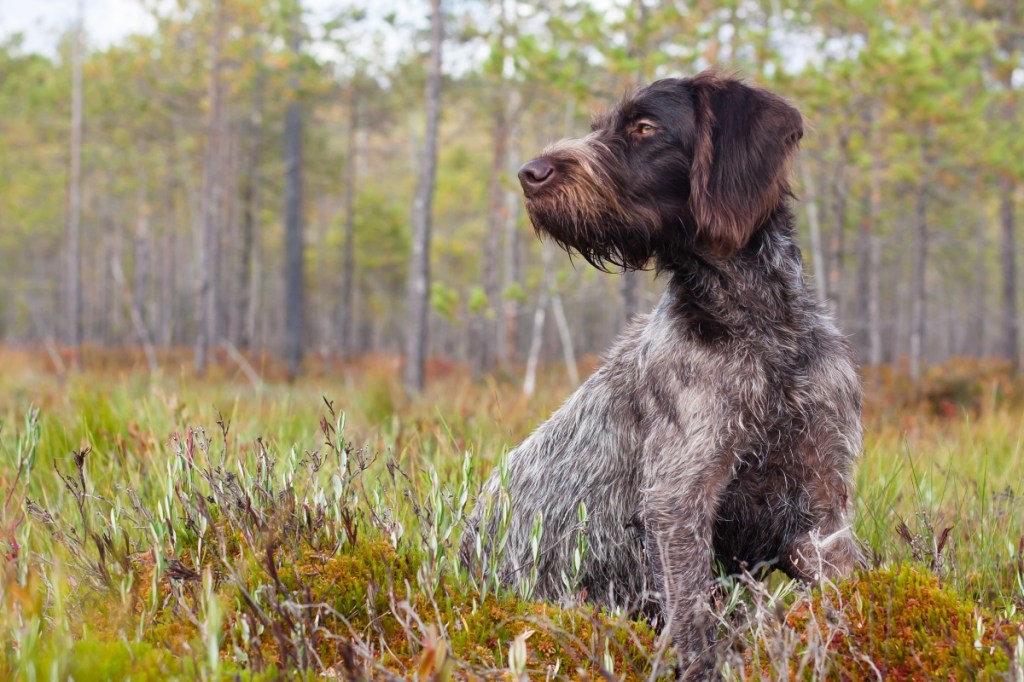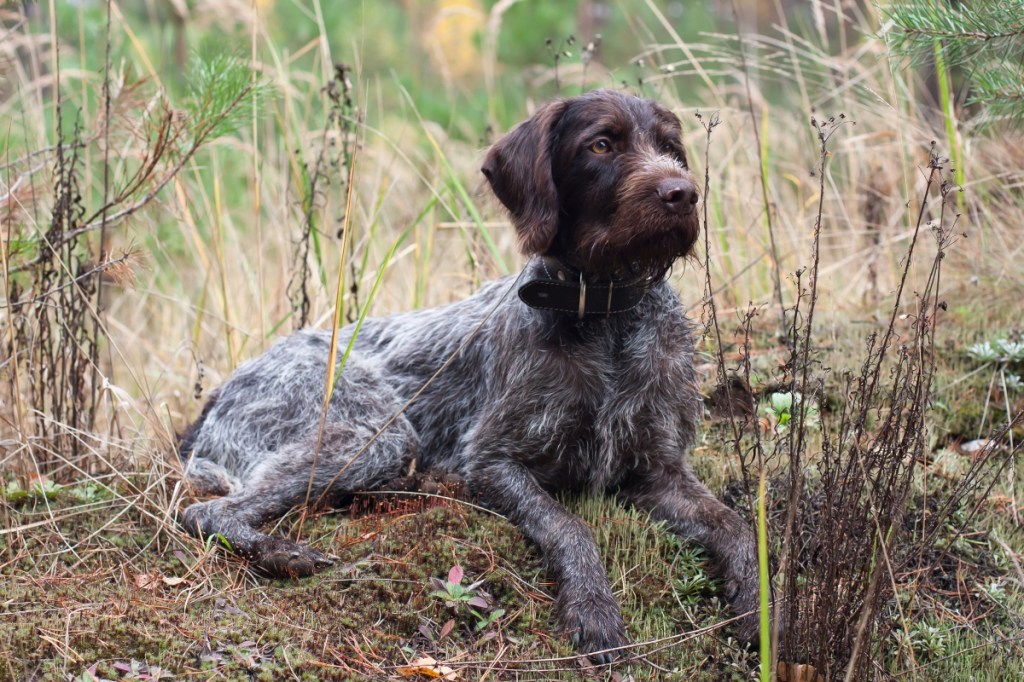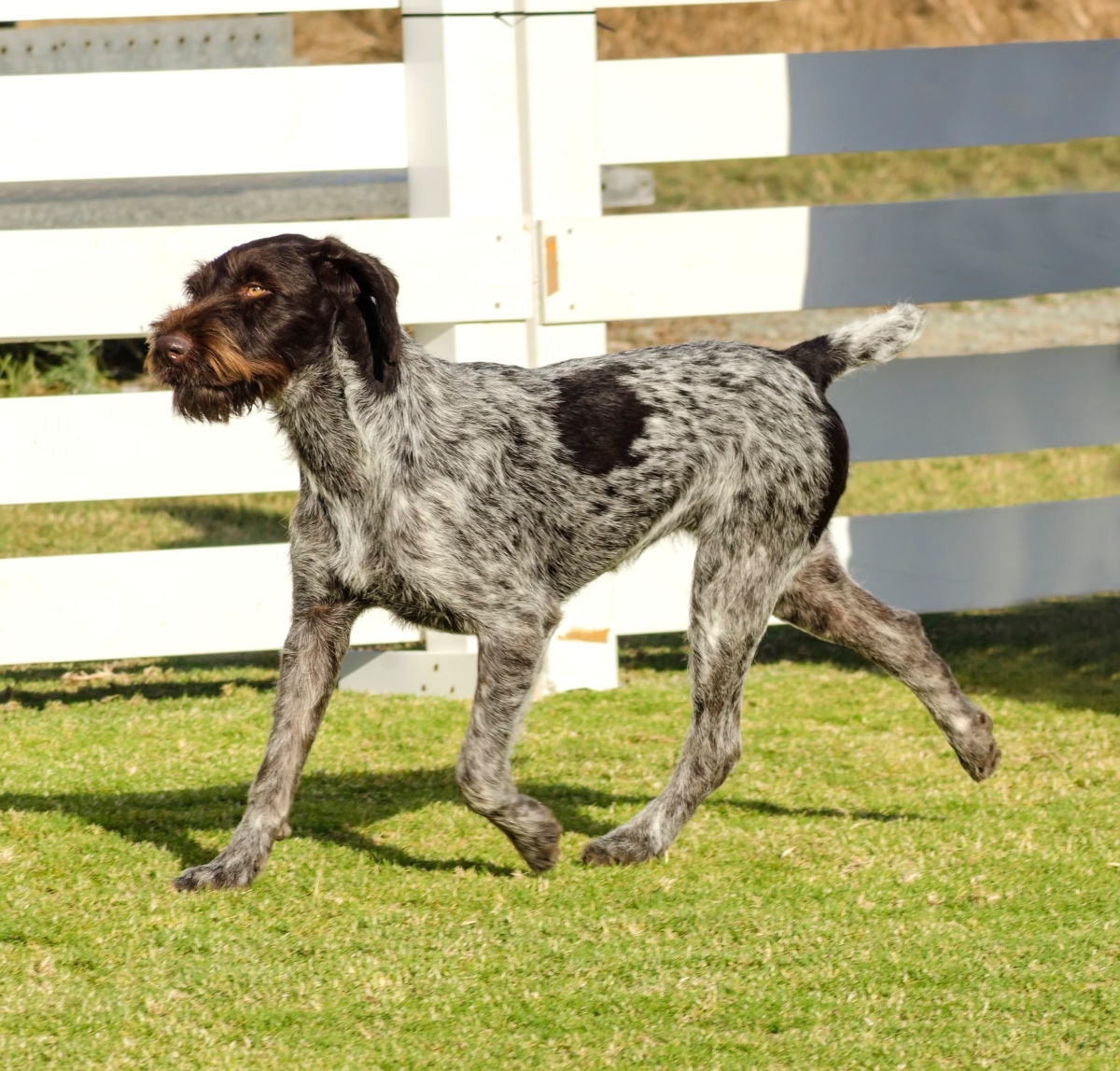Table of Contents
Introduction to German Wirehaired Pointers
German wirehaired pointers are enthusiastic and eager dogs that are full of life. This versatile breed of dog loves being outdoors and is affectionate with family members. Families who love sports and exercising outdoors are an excellent fit for German wirehaired pointers. With a medium size and intelligent mind, German wirehaired pointers excel at hunting, being watchdogs, and retrieving objects on land and in water.
To learn more about this breed and whether it is right for your lifestyle and temperament, read on for information about the German wirehaired pointer and how to take the best care of your dog’s health!
Size of German Wirehaired Pointers
The German wirehaired pointer is considered to be a medium size dog because it grows to 50 to 70 pounds in weight and 22 to 26 inches in height. Female dogs tend to be about 22 inches tall, while males grow to 24 to 26 inches. A German wirehaired pointer will be fully grown by about 15 months.
Below is a chart detailing how big you can expect your German wirehaired pointer to get as the dog grows from puppyhood to adulthood. Female weights tend to be below these averages, while male weights are slightly more than these figures.
| Weight Chart | 3 months | 6 months | 9 months | 12 months | 15 months |
| Male and female German wirehaired pointers | 30 lbs. | 47 lbs. | 56 lbs. | 63 lbs. | 68 lbs. |
Characteristics of German Wirehaired Pointers
The temperament of a German wirehaired pointer is very active and confident. These are dogs that need strong and confident human leaders to guide and train them, or otherwise, they can become dominating pets.
German wirehaired pointers need a lot of exercise for their physical health and mental stimulation. If they become bored, they could become destructive or be tempted to escape and roam because of their strong hunting instincts.
As you get to know a German wirehaired pointer’s personality, here’s what you can expect based on his or her breed characteristics:
| Breed Characteristic | Level (High, Medium, Low) |
| Affectionate with People | High |
| Good with Kids | Medium |
| Good with Pets | Medium |
| Need for Exercise | High |
| Energy Level | High |
| Intelligence Level | High |
| Able to Be Trained | High |
| Amount of Barking | Medium |
| Amount of Shedding | Low |

History of German Wirehaired Pointers
German wirehaired pointers were bred by German and British sportsmen to be hunting dogs for birds. These sportsmen trained them to be versatile hunters that could retrieve game from land and water. They were bird dogs that could really do it all and have been cherished hunting companions since the early 1800s. The breed combined some of the best aspects of the pointer, poodle, and foxhound. Resilient against nearly any type of weather and able to navigate nearly any kind of terrain, the German wirehaired pointer became distinguished from the German shorthaired pointer because off its coat, body length, head shape, and temperament.
The breed’s name comes from the English translation of the German breed name, Deutsch-Drahthaar. The dogs were first imported to America in the 1920s, and the American Kennel Club first recognized the breed in 1959. While many of these dogs live their lives solely as household companions today, they are still used for hunting as well.
German Wirehaired Pointer Standard Information
The breed standard by which German wirehaired pointers are judged at shows describes the breed as well-muscled, balanced in size, and sturdily built. These determined hunters have weather-resistant, wire-like coats and distinguishing facial features.
For more information about their physical characteristics, here is an overview of the breed standard information for German wirehaired pointers:
Head:
- Moderately long head
- Brown, medium-sized eyes that are oval and bright
- Rounded ears that are not too broad
- Fairly long muzzle
- Dark brown nose with nostrils wide open
Neck, Topline, Body:
- Medium-length neck that is slightly arched
- Skin is tight to the body
- Back is short, strong, and straight
- Tail is set high and docked to approximately two-fifths of the original length
Forequarters:
- Shoulders are well laid back
- Forelegs are straight, with elbows close
- Dewclaws are usually removed
- Feet are webbed with high arches and thick, hard pads
Hindquarters:
- Thighs are strong and muscular
- Hocks are short, straight, and parallel
- Dewclaws are usually removed
Coat:
- The wiry coat is the breed’s most distinctive feature
- Weather-resistant and water-repellent to some extent
- Undercoat is dense for winter insulation but thin in the summer
- Coat should have a natural, not over-groomed appearance
Color:
- Liver and white coat
- No black coloration in the coat
Gait:
- Moderate gait that is free and smooth
- Long, ground-covering stride

Caring for German Wirehaired Pointers
German wirehaired pointers do not make the best apartment dogs because they need space to run and play outdoors. The breed can become high-strung and restless if kept indoors for too long and not given the opportunity to have a yard with ample space. It can be challenging for even the most active families to keep these dogs properly exercised. They are moderately adaptable dogs that do slightly better in warm weather than in cool weather. German wirehaired pointers can develop separation anxiety if they are left alone for long periods of time, and they can be suspicious and aloof with strangers. All of these breed-specific facts influence how to best take care of your dog to ensure a happy and healthy life.
Here are some general tips for taking the best care of a German wirehaired pointer:
Best Living Environments:
- No apartments
- House with a fenced yard is best
- Places with easy access to outdoor recreation
Type of Exercise:
- Hunting and chasing games
- Covered dog run for outdoor play without the risk of escape
- Walks, runs, and hikes with family members
- Can run alongside a bicycle
- Light swimming in safe bodies of water
Mental Enrichment:
- Games of fetch with the family
- Vigorous exercise to stimulate the mind
- Quality time indoors with loved ones
Training Strategies:
- Fairly easy to train
- Keep training sessions unique and interesting to keep this intelligent dog stimulated
- Work on controlling the strong prey drive
- Has the potential for mouthiness and wanderlust
Grooming Tips:
- Minimal grooming is required
- Regular brushing will keep the dog clean
- Bathe only as needed when dirty
- Dries quickly after a bath due to water-repellent coat
- Trim nails regularly unless worn down from outdoor exercise
Common Health Problems of German Wirehaired Pointers
German wirehaired pointers have great longevity and an average lifespan of 14 to 16 years. These are generally healthy dogs, but certain genetic and age-related conditions can develop with each passing birthday.
These are some of the most common health issues that arise with German wirehaired pointers:
- Hip dysplasia (a genetic condition)
- Elbow dysplasia (a genetic condition)
- Entropion (inward rolling of the eyelid)
- Cataracts (develops in senior dogs)
- Von Willebrand’s disease (inherited blood disorder)
- Ear infections
- Skin cancer
- Gastric Dilatation and Volvulus (bloat)
- Osteochondritis dissecans (a joint disorder)
- Hypothyroidism (low thyroid hormone production)

Diet and Nutrition for German Wirehaired Pointers
Fully grown German wirehaired pointers need 2.5 to three cups of dry dog food per day. The dietary needs of a German wirehaired pointer vary based on the dog’s age, level of activity, and health conditions.
Where to Adopt or Purchase German Wirehaired Pointers
One resource to know if you love this breed is the German Wirehaired Pointer Club of America, which offers a breeder listing, stud dog directory, and national events that involve the breed. There are also German wirehaired pointers that end up in dog shelters because their previous pet parents weren’t able to keep up with their energy levels and exercise needs. You might start your search for an adoptable dog at the National German Wirehaired Pointer Rescue, the official rescue of the breed club, or another local or regional rescue organization that is familiar with this dog breed.
Related Breeds
German wirehaired pointers are certainly unique dogs, but there are other breeds that share common qualities that you may be interested to learn about as well. Here are some similar and related breeds to the German wirehaired pointer:
- German shorthaired pointer
- Polish water dog
- Stichelhaar
- Griffon
- Drahthaars
- Chesapeake Bay retriever
Pet Insurance for German Wirehaired Pointers
Regardless of how young or old your German wirehaired pointer is, pet insurance is an excellent idea. These very active dogs are prone to accidents and injuries because of their high intensity and need to constantly be active.
Fortunately, Healthy Paws provides coverage for new accidents that your German wirehaired pointer may encounter so that you can pay for veterinary treatment without worrying about the cost. Our German wirehaired pointer health insurance plan also covers breed-specific conditions, genetic conditions, emergency care, cancer, and alternative care that your furry friend may need.
To learn more, contact us at 855-898-8991 or request your online dog insurance quote today.









